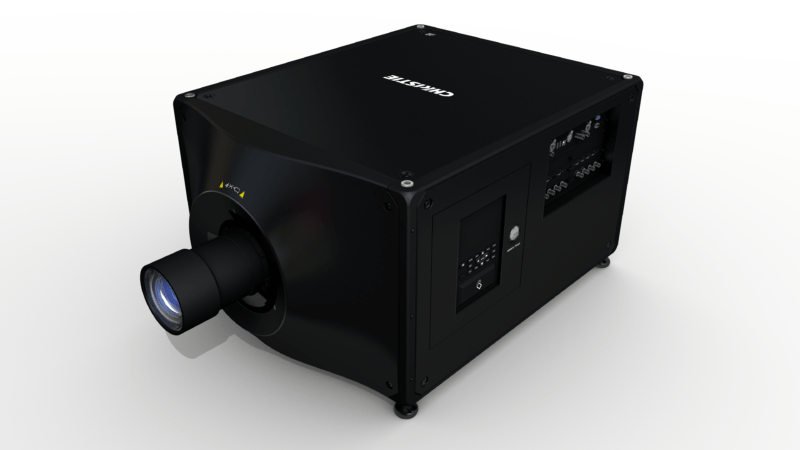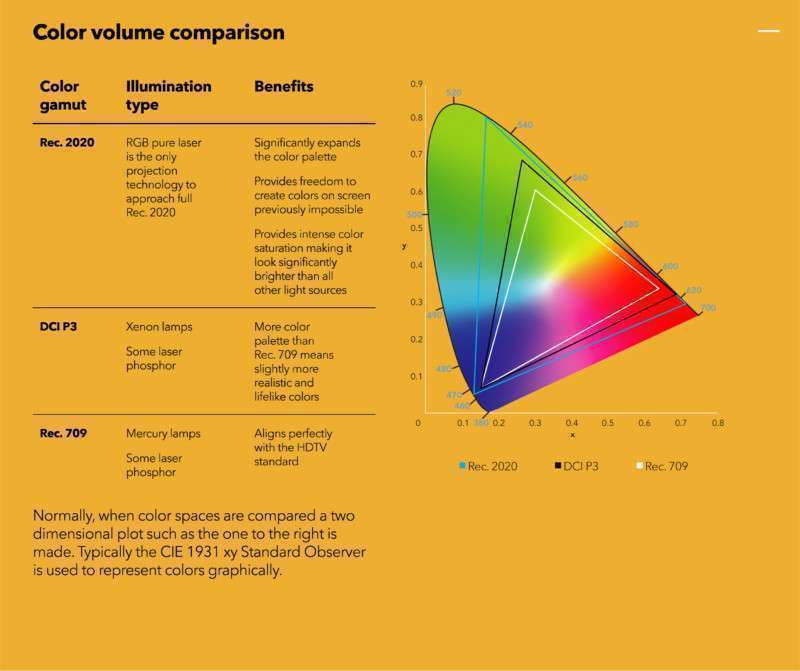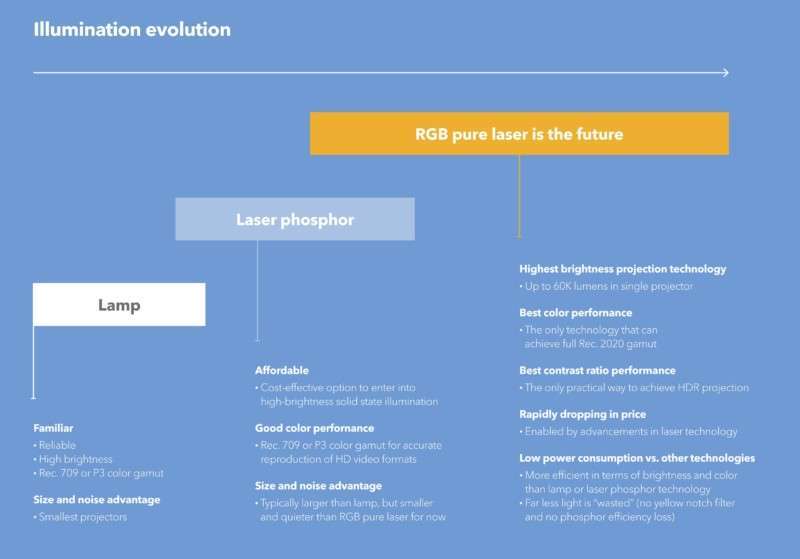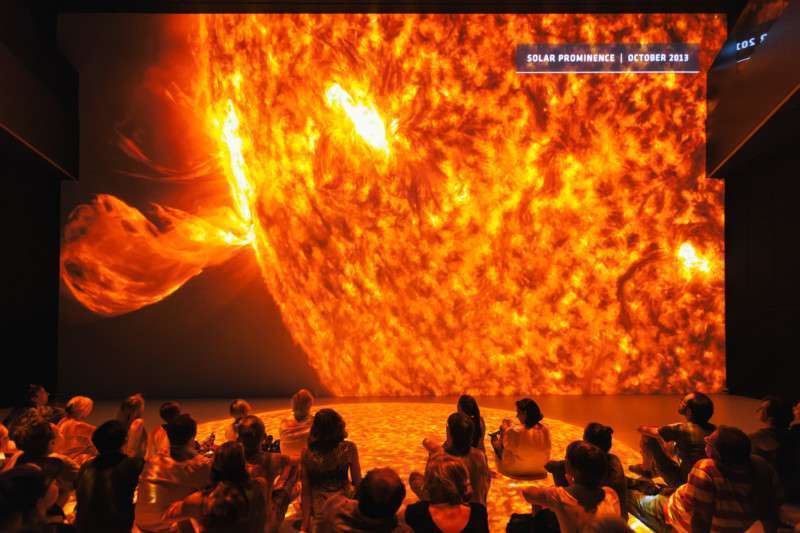Christie rolls out new RGB laser products for entertainment and a universe of color
By Judith Rubin
Christie has made a substantial investment of time and resources in RGB laser projection and recently introduced two, new DLP projector models designed specifically to meet the needs of the LBE sector: the Mirage SST and D4K40-RGB. They’ve been showing these projectors at LDI, the IAAPA Expos, ISE, and other forums over the last 12 months or so. Christie anticipates high demand for the new projectors, and reports that displays and demonstrations in the field are met with enthusiasm.
Market sectors seen as a particularly good fit for RGB laser projection include giant screen cinema, projection mapping, branded experiences, digital domes and immersive attractions – both temporary and fixed installations.
Why RGB laser specifically, and why now? The technology at Christie has progressed to that stage where the latest iterations have become more affordable, compact, robust and energy efficient, and thereby within reach of a wider market segment and with the stability and longevity that solid-state construction confers. In terms of what it can put on the screen, a most important attribute is that RGB laser technology facilitates a leap forward in the color space a projector can produce, and that is making creatives dream. The ability of Christie RGB laser projectors to support the expansive Rec. 2020 color palette is something to delight audiences with visual richness and range (think art and nature) – while also able to fulfill business needs with its precision (think branding and IP).
Meet the RGB laser projectors

The Christie D4K40-RGB (above) is an all-in-one unit that began shipping in December 2018. Christie Senior Product Manager Mike Garrido describes it as “a small form factor, all in one, no external chillers, like a standard lamp projector.” It weighs 285 lbs and measures 37 x 28 x 21.8 inches. The Mirage SST, set to begin shipping in early spring 2019, features an ultra- compact, lightweight, remote projection head that connects to the laser light source via a fiber connection, providing installation flexibility. (Projector head is 26.8 x 23.5 x 12 and 110 lbs; laser unit is 30.6 x 31.7 x 25.7 and 330 lbs. Laser unit weight does not include optional chiller.)
Reportedly, both projectors deliver greater than 90 percent of Rec. 2020 color space and native 4K resolution. The new projectors are also compatible with Christie 4K lenses and its suite of software tools. Beyond that, RGB laser projection is part of a whole-product gestalt with supporting, compatible hardware and software from production to exhibition. This is Christie’s second-generation rollout of RGB laser units, and reflects considerable market research as well as R&D.
For big screens, the time is now
The technology holds special promise for giant flat screens and domes that predominate in science centers, natural history museums and planetariums. The giant screen cinema market has struggled to find digital projection solutions that deliver image quality as good or better than the aging, 15/70mm film delivery systems upon which the industry was founded in the 1970s. Planetariums have been facing similar challenges in seeking to replace or augment legacy optomechanical “starball” projectors to fill their theater domes. Excepting the smallest venues, the digital systems that replace these legacy systems require multiple projectors for optimal image quality.
The company has done its homework. In a white paper for Christie, industry consultant Gord Harris states that “RGB laser systems have the potential to significantly improve Giant Screen image quality while substantially lowering operating costs,” and that “multi-projector systems coupled with proven auto-calibration systems for warping and blending can now far outperform single 4K projector solutions.” Harris, a giant screen industry veteran, goes on to relate RGB laser projection capabilities to the DIGSS 2.0 spec (Digital Immersive Giant Screen Specifications), and show how the technology can help giant screen exhibitors preserve (or recapture) their industry’s key differentiators of image quality and aspect ratio.
“There’s reason to believe that there’s a market for this,” says Bryan Boehme, Executive Director of Global Sales & Business Development, Entertainment at Christie. Boehme, who sits on the Technical Committee of the Giant Screen Cinema Association (GSCA), says, “Giant screen cinema was built on differentiation, on providing something scalably different. For years, that was 15/70 film. Film to digital conversion in giant screen has taken some time, and some of those were early adoption. This will be a next step for them. In mainstream theaters, it will be years before we see RGB laser widely embraced, but it’s an option for specialty cinema now.”
Like Harris, Boehme makes the case that Christie’s RGB laser projectors can restore differentiation and distinction to these theaters – even the legendary venues with eight-story-high screens – treating audiences to everything RGB laser projection has to offer, including its expanded color range. Boehme indicates that RGB laser projection capability is matched by content production tools, that both RED and Sony, among others, have high-end digital cameras on the market now that support the Rec.2020 color palette, and that most existing theaters already have the standard matte screens for best exhibition results.
Christie’s partners in this arena include Evans & Sutherland, a leader in the fulldome community. “E&S recently took delivery of their first five RGB laser units (D4K40-RGB projectors) for their demo center in Utah and an additional five for the U.S. Space and Rocket Center in Huntsville, Alabama,” said Boehme.
Boehme and Garrido pointed out that the same qualities (versatility, color saturation and brightness, multi-unit capability, etc.) that make RGB laser projection well- suited to giant screens also apply to projection mapping, nighttime spectaculars, touring productions and concerts, sports events, story-based experiences for theme parks, visitor centers, museums, immersive art displays, historical re-creations, world expo pavilions and more.
Garrido said, “One of our big partners has been talking about how, going forward, RGB laser technology will allow them to do new things, supporting ROI on several levels. The color range allows effects and animations not before possible. It supports extremely punchy animation. It can have great impact on a dark ride experience, touching theatrical lighting and effects in addition to the projection light on the screen. It helps everything to stand out and tell the story properly, in addition to being reliable and robust.”

Rec. 2020 and the color space
For a deep dive, see the white paper on Rec. 2020 and laser projection prepared for Christie by Matt Cowan at www.christiedigital.com/techpapers/rec-2020-whitepaper.pdf.
Three key points:
- Rec. 2020 color is a superior color space in terms of representing the real world and achieving precise color matches. It can reproduce colors not possible with Rec. 709 (associated with HDTV) or P3 (associated with DCI, the Digital Cinema Initiative).
- RGB laser projection supports Rec. 2020.
- Once you’ve seen the Christie color demo shootout of Rec. 2020 vs Rec. 709 and P3, as Bryan Boehme says, “You can’t unsee it.”
“Rec. 2020 color provides the opportunity to display a better representation of real-world colors than the commonly used color spaces for television and cinema,” states color scientist and entertainment specialist Matt Cowan in a 2015 white paper on Rec. 2020 and RGB laser projection prepared for Christie. “The standards committee for Rec. 2020 chose color primary coordinates that are at the extreme edge of the visible color space. These color primaries are achievable with RGB laser illuminated projection technologies. Practically achieving these primaries is not limited to single wavelengths, but can be accomplished with a bundle of wavelengths. RGB laser illuminated projectors are ideal for achieving this.”
As mentioned above, there’s an aesthetic power and a business incentive for working in the Rec. 2020 color space. “This is what creative people in LBE have been asking us for: a larger creative palette, a palette that allows them to do things bigger and bolder than ever seen before,” says Boehme. Adding that today’s entertainment universe is increasingly populated by licensed and branded content and characters, the power to achieve the exact color – whether for skin tone, a costume, a mascot, art reproduction, a product or company logo, a sports uniform, etc. – is all-important.
Garrido has been meeting with customers and partners in live events staging and LBE development and reports that across the board, “They all love the colors. Most are looking for punchiness in image, something that catches the eye and will not fade into the background, that remains vibrant even in ambient light, that stands out even in very large format situations. That’s what RGB pure laser allows. Authentic, vibrant colors. Detail and crispness.” Those viewers are perceiving something called “color volume,” according to Garrido. “Color volume gives the impression of higher brightness, but it really is color saturation.”
“People are blown away by the ability to see that much more color,” says Boehme. “For many years, Rec. 709 was interpreted as the best color we’d be able to produce with projectors. We’re about to shed that.” He emphasizes that it’s necessary to see Rec. 2020 in person. “You can’t take a picture of it – our phones are all color spaced at Rec. 709. Once you do see it, you can never go back to thinking about color, or color reproduction, the same way.
Wavelengths don’t change
Christie continues to invest in and market 3DLP and 1DLP laser phosphor projectors, while positioning RGB laser projection as the pinnacle of laser-illuminated projection.
The “RGB” in RGB laser denotes Red, Green and Blue, and refers to its use of individual red, green and blue lasers to generate light, a key differentiator from the more commonly known laser phosphor projection, as well as from lamp-based projection.
Both laser phosphor and RGB laser are lampless technologies; the key difference is how the light is produced. Laser phosphor uses blue laser diodes as the primary light source. To generate the three primary colors – red, blue, green – the blue light from the laser diodes shines onto a spinning wheel that is coated in a phosphor compound. The blue light excites the phosphor, emitting yellow light. The yellow light is then segmented using dichroic coatings to create red and green light while the blue light component directly passes through a diffusion segment in the phosphor wheel.
RGB laser, on the other hand, is not only lampless, it is wheel- less and solid-state. It employs individual red, green and blue laser diodes as its light source, and they are scalable. The scalability supports ever increasing levels of brightness and the individual, primary
color diodes support the Rec. 2020 color palette.
Consistency is another benefit. The Rec. 2020 color palette and the RGB laser light provide accuracy, range, and consistency. RGB laser light does not degrade the color as the projector ages (as opposed to lamp-based projection). As a result, the RGB laser projector has the power to readily match a display again and again – a boon for branded content and situations where the projectors will be repeatedly switched on and off, such as for a touring show, traveling museum exhibit or convention presentation. “When specific colors are used in a production, the client wants and expects to see those colors,” says Garrido. “One of the things that our customers in rental and staging are very pleased with is how the Christie RGB laser projector can store and recreate the color again and again.”
Solid state manufacturing plus RGB pure laser light is key to consistency, even as the units age, according to Christie, because wavelengths don’t change. “With lamps, you have gases, anodes and cathodes, a yellowing glass,” Garrido says. “With RGB lasers and solid state, you have a very predictable aging characteristic. As they get older, they lose light. Not quality of light – wavelengths don’t change, which is why you’re able to precisely recreate color.” After 30,000 hours the unit will have lost 20% of its initial brightness, according to Garrido. “If you bring in a new projector, you can turn that one down to match, or replace the laser optical system on the aging projector. And they don’t age as quickly as lamp-based projectors do.”

Efficiency
Additional benefits attributed to Christie RGB laser projectors vs lamp-based are that they deliver more light more efficiently, with less power. It’s partly due to the nature of RGB laser light, Garrido explained. “RGB laser light wants to stay in a straight line, but the light from a lamp wants to scatter,” he says. “So by nature, in RGB laser projection you have less stray light to deal with, and a better contrast ratio as a result. This is further improved by the high contrast lenses used in RGB laser projectors; they have elements that help control the scattering of light.”
Heat generation and form factor are attributes that add up, positively, when considered along with lighting, HVAC and other systems, especially in a limited-footprint, fixed install space. Per Garrido, “RGB laser illumination has a lot less thermal output (10,000-15,000 BTU per hour) than a lamp-based product (17,000-20,000 BTU per hour).” Wiring and connection needs are also simpler and more in line with what most venues typically have available, noted Garrido: single phase power for the RGB laser projector vs 3-phase power for a 7 kw lamp-based projector. “An installation can replace its existing projection system with a Christie D4K40-RGB to fill a 25-foot screen and give its customers a compelling, new experience. It’s an all-in-one box with no external components – an easy replacement with existing infrastructure. You hang it and turn it, in any orientation, paying attention to normal concerns such as providing clearance for air circulation and exhaust, and a safety zone around the laser source. These are some of the things that customers have gotten excited about when we started showing off the product,” says Garrido. “They see how easily they can upgrade.”
The promise of RGB laser
A well-established leader in AV, Christie has a 90-year history and track record of active involvement and outreach among its customer base. The dialogue and partnership with creatives and integrators helps the company keep its business verticals aligned and its products on target. [See “Relationships, Passion and Quality, InPark issue #71, https://www.inparkmagazine.com/ christie-relationships-passion-and-quality/]
RGB laser has some very big screens to fill, and Christie is on the job. • • •

Want to learn more?
To understand more about why color volume matters, and see how lamp and laser technologies compare on key features and cost of ownership, download the free e-book “Illuminating ProAV” at
christiedigital.com/illuminationguide






